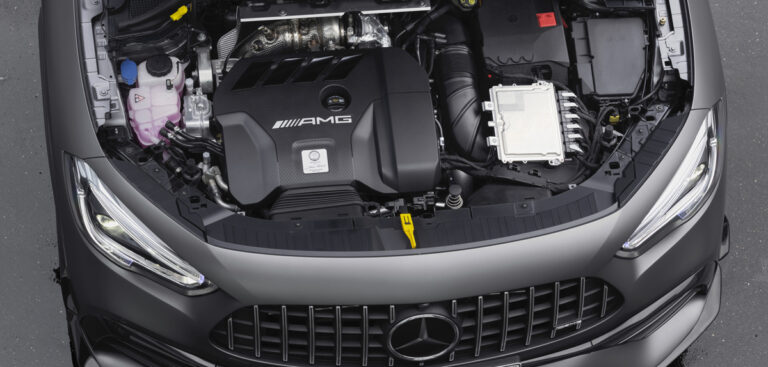Mercedes AMG GLA 45 to house the world’s most powerful series-produced four-cylinder turbo engine that pushes out 382PS and 480nm of torque.
In previous models of the 35-series AMG, the engine has been transversely mounted, but the powertrain in the GLA 45 has been turned around 180°on its vertical axis. This means the turbo and exhaust manifold are now positioned nearest the firewall, allowing for improved air ducting and a better flow rate on the intake and exhaust side.
A new twin-scroll turbocharger houses a compressor and turbine wheel-mounted on anti-friction bearings, that responds quickly at both high and low engine speeds, reaching a maximum speed of 169,000rpm. An electronically controlled wastegate allows charge pressure to be closely monitored and optimizes throttle response when accelerating through the rev range. The powertrain delivers 480nm of torque between 4,750-5,000rpm, while having a similar power delivery of a naturally aspirated engine. The above helps the engine to complete 0-96km/h in 4.3 seconds, reaching a top speed of 249km/h.
Mating the powertrain to the drivetrain is an 8-speed dual-clutch transmission with optimized gear ratios for responsive up shifting characteristics, and an automatic double-declutching system to assist in smooth down-changes. Also featuring is a fully variable all-wheel-drive system linked to a newly designed rear differential, which via two electronically controlled multi-disc clutches can distribute power between the front and rear axle, and individual rear wheels. The combined result is consistent traction in differing situations on a multitude of road surfaces. Mercedes state that the main advantage of an electromechanical control system is a significantly faster vehicle response culminating in a more refined driving dynamic.
Alongside this, AMG engineers have developed an intelligent new cooling system for the vehicle, allowing the cylinder head and crankcase to be at different temperatures. The system comprises of a mechanical water pump for the head, enabling maximum output and efficient ignition timing, while the crankcase is warmed by an electronic high-performance water pump reducing in-engine friction. During operation, the ECU monitors temperature differences ensuring both the cylinder head and crankcase are at optimal temperatures for a range of situations.
The 2.0-liter engine is entirely assembled by hand at the specially designed production facility in Affalterbach, Germany, where Mercedes continues to implement the one man, one engine ethos.


